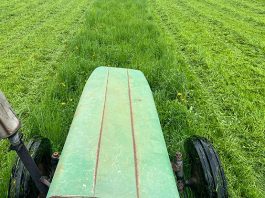Days are shorter and heat units waning, so in most areas, good growth days, even if we get some adequate rain, could be limited. That means that we need a plan for taking our livestock through the winter.
 The first question that comes to mind is, “Will there be enough feed or forage for all the livestock until spring?” It is generally a good idea to evaluate and balance grazing livestock with available feed. I would first look at all the grazing type animals present. Take different classes (cows, heifers, stockers, ewes, etc.) and figure an average weight per class and then multiply that number times the number of each class. For example, thirty-five cows at 1,100 pounds is 38,500 pounds live weight, twelve spring calves kept back at 550 pounds and a 1,775 pound bull…let’s see that all totals about 46,875 pounds live weight. Now, those calves are going to continue to grow some over winter even on just forages or hay so let’s say they will average 650 pounds over the next five months. Now our total is now 48,075 pounds live weight. The growing animals are usually going to have a higher metabolism rate, but to keep things simple, use the dry matter intake rate of 3% for all of them and that will get us in the ball park. So, 48,075 pounds live weight times 3% is 1,442 pounds of dry matter a day needed.
The first question that comes to mind is, “Will there be enough feed or forage for all the livestock until spring?” It is generally a good idea to evaluate and balance grazing livestock with available feed. I would first look at all the grazing type animals present. Take different classes (cows, heifers, stockers, ewes, etc.) and figure an average weight per class and then multiply that number times the number of each class. For example, thirty-five cows at 1,100 pounds is 38,500 pounds live weight, twelve spring calves kept back at 550 pounds and a 1,775 pound bull…let’s see that all totals about 46,875 pounds live weight. Now, those calves are going to continue to grow some over winter even on just forages or hay so let’s say they will average 650 pounds over the next five months. Now our total is now 48,075 pounds live weight. The growing animals are usually going to have a higher metabolism rate, but to keep things simple, use the dry matter intake rate of 3% for all of them and that will get us in the ball park. So, 48,075 pounds live weight times 3% is 1,442 pounds of dry matter a day needed.
Grazing Stockpile
The second question is what to feed those animals? Some stockpiled forage (perennial and annuals), crop residue, hay, and supplements? Let’s start with the stockpiled forage which is usually going to be tall fescue with some orchardgrass and clover mixed in. Generally, lay a clipboard or cardboard on top of the standing sward and then measure the height of the compressed forages. If the stand is pretty dense, then there is usually about 300 pounds per acre inch of dry matter. So, if you happen to have say, 10 inches, that is 3,000 pounds of dry matter per acre. You do not want to remove it all, so let’s say you remove six inches; that is 1,800 pounds available for grazing times the number of acres of this stockpiled forage. If fields vary, adjust as needed. The efficiency of grazing this will be dependent on how you allocate it out. If you let stock have the whole field then expect 60-75% utilization, at best you’ll have 1,800 pounds available. If you allocate it out like you are feeding hay with temporary fence providing one or two days’ worth at a time, you’ll find the efficiency to be up near 90 percent.
Watch Your “Waste-Line”

Now take inventory of any hay you have on hand. You should have an idea on how much bales weigh and how many you have of each. If you have one hundred 1,500 pound bales (1,300 pounds dry matter) on hand, you essentially have 130,000 pounds available. The efficiency of this hay is also dependent on how you feed it, plus how it is stored. The worst case scenario is hay fed free choice without any feeder structure and hay stored outside on the ground which sadly wastes about 45% of the offered hay. Feeding enough hay for only 2-3 days at a time (creating some competition between cows), in ring or cone type feeders and storing bales inside is pretty efficient with an average of about 15% waste….that is, of course assuming that the hay is good quality too. Small bales, fed in feeders, are probably the most efficient, but certainly a little more labor intensive and just not used as often as in the past. If you have silage or balage on hand to feed, figure it into the picture and generally expect 90% efficiency adjusted to dry weight.
What About Corn Stalks?
In some areas, folks can graze corn stalks. The nutritional value of corn stalks can certainly vary from year to year. Stalks will start out in the 8% crude protein range with approximately 70% total digestible nutrients (TDN) and over a period of about 60 days drop to 5% crude protein and 40% TDN. Spring calving cows will meet most of their energy needs during mid gestation. Growing animals such as calves and fall calving lactating cows may be lacking a little in energy and protein and most likely will need to be supplemented if run on stalks.
About one acre of typical corn residue will be needed per animal unit per grazing month. Weekly allocations seem to work very well so you need to figure how many acres of stalks will be needed for one week of grazing for your herd. Some areas of Indiana have very poor corn that may not be harvested this year. Just be aware if you are considering grazing these damaged corn fields that nitrates could be an issue along with other health issues if the stalks have been flooded. It is best to test before utilizing.
FROST WATCHOUTS!
We will also soon have our first frosts. Summer annual warm-season grasses; such as sudangrass or sorghum-sudangrass hybrids, and johnsongrass produce a cyanide compound when frosted and quickly starts shutting down, causing the production of the prussic acid. Livestock should be removed from these forages for at least two weeks to allow for the forages to “dry down” and the prussic acid to dissipate before grazing again. These forages can be harvested for balage right after being frosted and later fed as long as they are allowed their normal fermentation process time period of three or four weeks. Frosted areas could be only “pockets” in a field to start with. Any regrowth from the base of the plant after a frost can also be very high in prussic acid. If in doubt about nitrates or prussic acid – test before feeding or grazing!

Back to the inventory. Compare the amount of dry matter you will need for the livestock with how much you have. If we get enough rain in time, the stockpiled forage amount could certainly still increase. Now you know about how much dry matter you are going to need to get them through the winter and an idea on how much you have available to feed them. If you are a little short on forages, you can add some supplements such as corn gluten, soybean hulls, etc. into your feeding plan. In fact, you may want to anyway if hay quality is somewhat lacking, or if more energy is needed. In the formula above, we used 3% for the intake estimate which is actually a little high, but if we have a wet, cold winter, energy needs to keep warm will increase and any growing animals will also have higher needs…so it’s better to overestimate than to be short. Cold, wet, and especially muddy conditions will increase energy requirements. If you are still short on feed, then you will need to plan on either purchasing more hay or consider reducing numbers some. Hopefully, it all balances out and is better than snowballs.
Keep On Grazing!





I feed 4×5 baleage (50% moisture) out on the ground via a mechanical unroller, there is no way I’m wasting 45% of that hay.. come back in the late day and its all cleaned up with just a tiny bit left on the ground and trampled back in by the next day. Feeding 30 brood cows + 10-20 calves depending on time of year…
George, If you are feeding quality baleage as you say then no, you should be doing a very efficient job with very little loss. Hay stored outside and fed free choice will have the highest loss.
Right on Victor!
Comments are closed.